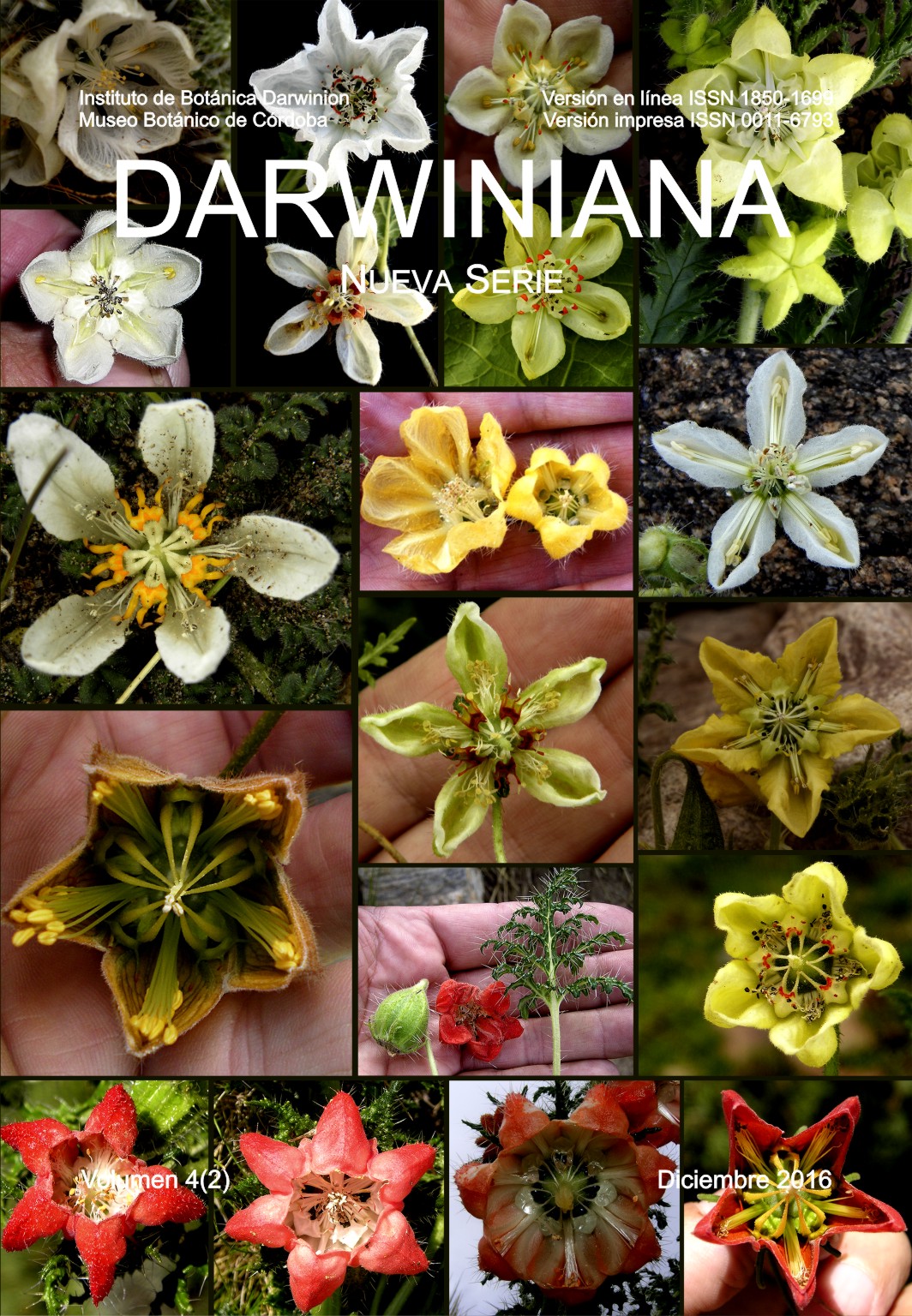Diversity and distribution of Diatrypaceae (Ascomycota) in Argentina and new records for the country.
DOI:
https://doi.org/10.14522/darwiniana.2016.42.687Keywords:
Argentina, Diatrypaceae, new records.Abstract
The family Diatrypaceae (Xylariales) includes mainly saprotrophic and some pathogenic species on wood of angiosperms. The aim of this study is to update the taxonomy and distribution of 30 species and species complexes of Diatrypaceae recorded in Argentina. Diatrype concolor, D. megale, D. polycocca complex, D. phaselina, Eutypa consobrina complex, Eutypella aspera and E. lophiostomoides are recorded for the first time and the distribution of five species is extended: Diatrype chlorosarca, D. enteroxantha - D. puiggarii complex, D. patagonica, D. wrightii and Peroneutypa scoparia. Eutypella bonariensis is proposed as synonym of Peroneutypa scoparia.References
Acero, F. J.; V. González; J. Sánchez-Ballesteros; V.
Rubio; J. Checa; G. F. Bills; O. Salazar, G. Platas &
F. Peláez. 2004. Molecular phylogenetic studies on the
Diatrypaceae based on rDNA-ITS sequences. Mycologia
(2): 249-259.
Carmarán, C. C. 2002. Contribución al estudio del orden
Diatrypales en las zonas subtropicales de la República
Argentina. Boletín de la Sociedad Micológica de
Madrid 26: 43-56.
Carmarán, C. C. & A. I. Romero. 1992. Problemas taxonómicos
en el orden Diatrypales. Contribución a su
esclarecimiento I. Boletín de la Sociedad Argentina de
Botánica 28: 139-150.
Carmarán, C. C.; M. B. Pildain & L. N. Vasilyeva. 2009. The
family Diatrypaceae (Ascomycota) in Argentina: new species
and new records. Nova Hedwigia 88: 521-530. DOI:
http://dx.doi.org/10.1127/0029-5035/2009/0088-0521
Carmarán, C. C.; C. A. Robles; M. F. D’Jonsiles; E. Ceriani; E.
Español; S. Lopez & M. V. Novas. 2014. Clave para la identificación
de especies de la familia Diatrypaceae (Xylariales,
Ascomycota). Lilloa 51: 20-32.
Carmarán, C. C.; A. I. Romero & L. M. Giussani. 2006. An approach
towards a new phylogenetic classification in Diatrypaceae.
Fungal Diversity 23: 67-87.
Chacón, S. 1999. Primer registro del género Echinomyces (Ascomycotina,
Diatrypales) para la micobiota de México. Acta
Botánica Mexicana 49:15-17.
Chacón, S. 2002. Taxonomic notes on the genus Endoxylina
(Diatrypales, Ascomycotina) and description of a new species
from Mexico. Fungal Diversity 11: 61-68.
De Scenzo, R.A.; S. R. Engel, G. Gomez, E. L. Jackson, G. P.
Munkvold, J. Weller & N. A. Ireland. 1999. Genetic analysis
of Eutypa strains from California supports the presence
of two pathogenic species. Phytopatology 89 (10): 884-893.
DOI: http://dx.doi.org/10.1094/PHYTO.1999.89.10.884
De Errasti, A.; C. C. Carmarán & M. V. Novas. 2010. Diversity
and significance of fungal endophytes from living stems of
naturalized trees from Argentina. Fungal Diversity 41 (1):
-40. DOI: 10.1007/s13225-009-0012-x
De Errasti, A.; M. V. Novas & C. C. Carmarán. 2014. Plant-fungal
association in trees: Insights into changes in ecological
strategies of Peroneutypa scoparia (Diatrypaceae). Flora
Morphology, Distribution, Functional Ecology of Plants
: 704-710. DOI:10.1016/j.flora.2014.07.006
Glawe, D. A. & J. D. Rogers. 1982. Observation of the anamorph
of six species of Diatrype and Diatrypella. Canadian
Journal of Botany 60 (3): 245-255. DOI: 10.1139/b82-033
DARWINIANA, nueva serie 4(2): 263-276. 2016
Grassi, E.; M. B. Pildain, L. Levin & C. C. Carmarán. 2014.
Studies in Diatrypaceae: the new species Eutypa microasca
and investigation of ligninolytic enzyme production.
Sydowia 66 (1): 99-114.
Kirk, P. M.; P. F. Cannon, D. W. Minter & J. A. Stalpers.
Dictionary of the Fungi, 10th ed. CAB International,
Wallingford.
Péros, J. P. & G. Berger. 2003. Genetic structure and variation
in aggressiveness in European and Australian populations of
the grapevine dieback fungus, Eutypa lata. European Journal
of Plant Pathology 109: 909-919. DOI: 10.1023/B:EJPP.
10264.62
Pildain, M. B.; M. V. Novas & C. C. Carmarán. 2005. Evaluation
of anamorphic state, wood decay and productions of
lignin-modifying enzymes for Diatrypaceaous fungi from
Argentina. Journal of Agricultural Technology 1: 81-96.
Pointing, S. B.; M. M. Parungao & K. D. Hyde. 2003. Production
of wood-decay enzymes, mass loss and lignin solubilization
in wood by tropical Xylariaceae. Mycological
Research 107: 231-235. DOI: http://dx.doi.org/10.1017/
S0953756203007329
Rappaz, F. 1987. Taxonomie et nomenclature des Diatrypacées
à asques octosporés. Mycologia Helvetica
(3): 285-648.
Romero, A. I. & C. C. Carmarán. 2003. First contribution
to the study of Cryptosphaeria from Argentina. Fungal
Diversity 12: 161-167.
Romero, A. I. & D. W. Minter. 1988. Fluorescence Microscopy:
an aid to the elucidation of ascomycete structures. Transactions
of the British Mycological Society 90 (3): 457-470.
DOI: 10.1016/S0007-1536(88)80156-6
Samuels, G. & F. Candoussau. 1996. Heterogeneity in the Calosphaeriales:
a new Calosphaeria with Ramichloridium- and
Sporothrix-like synanamorphs. Nova Hedwigia 62: 47-60.
Thiers, B. [permanentemente actualizado, consulta 2016] Index
Herbariorum: a global directory of public herbaria and associated
staff. New York Botanical Garden’s Virtual Herbarium.
Disponible en http://sweetgum.nybg.org/ih
Vasilyeva, L. N. & S. L. Stephenson. 2005. Pyrenomycetes of
the Great Smoky Mountains National Park. II. Cryptovalsa
Ces. et De Not. and Diatrypella (Ces. et De Not.) Nitschke
(Diatrypaceae). Fungal Diversity 19: 189-200
Published
How to Cite
Issue
Section
License

Starting on 2012, Darwiniana Nueva Serie uses Licencia Creative Commons Atribución-NoComercial 2.5 Argentina .






